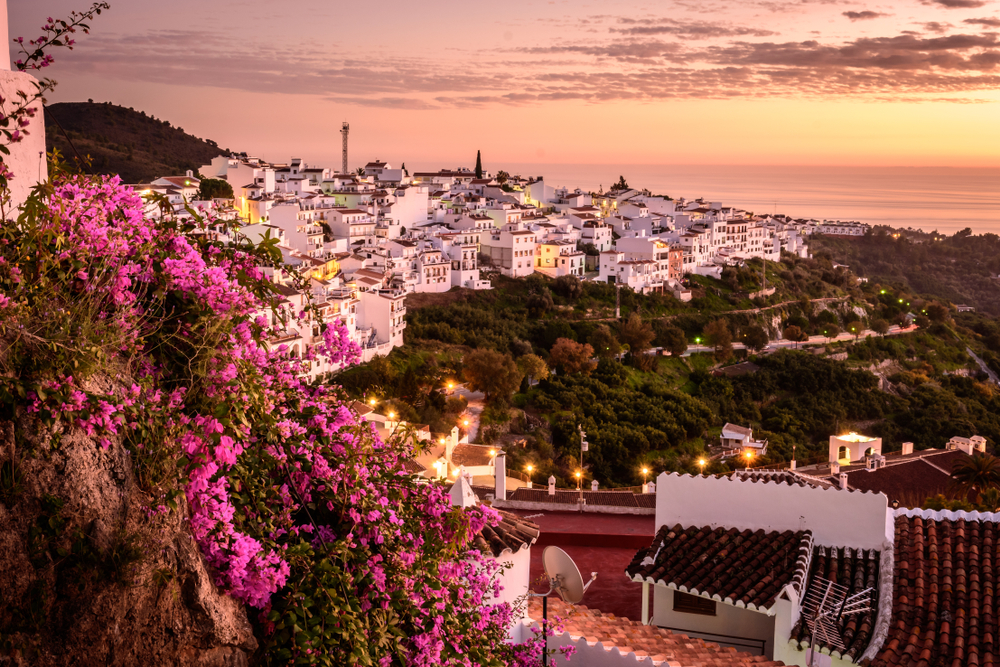The picturesque white mountain village of Frigiliana on the edges of the Sierras de Tejeda Natural Park in Andalusia captivates with its white houses that shine at you from afar.
With its narrow streets, the edges of which are decorated with flowers and decorations, Frigiliana is still in typical Moorish style.
At the end of August, the Festival de las Tres Culturas – the Festival of the Three Cultures – is held in Frigiliana every year. It celebrates the coexistence and confluence of Christian, Muslim and Jewish traditions in the region. Part of the festivities are numerous live performances and street performers. Music and gastronomy are dedicated to these cultures on this occasion. Exhibitions also take place in the course of the festival.
Attractions in Frigiliana
Castillo de Lizar
Once upon a time, the Castillo de Lizar towered over Frigiliana. Today, however, hardly the foundation of the fortress remains. In 1569, the Arab castle was destroyed by a Christian army and never rebuilt.
The Castillo was built between the 9th and 11th centuries on the top of Cerro de la Sabina and occupied a total area of 4000 square meters.
For a time, the fortress housed the Moorish rebels from Malaga and Granada who had fled there from the king’s suppression of their culture and religion. However, they also had to surrender to the troops and the fortress was destroyed.
Although there are only a few remains of the fortress itself, from the summit you have a wonderful view of the village and its surroundings as far as the Mediterranean Sea when the weather is nice.
The Church of San Antonio de Padua
This typical Andalusian church was built in the 17th century on the former site of a mosque.
For the most part, it was kept in the Renaissance style. It is very simple and the ceiling inside is made of wood. Some of the original frescoes can still be seen in their entirety.
The statues are, as is customary in Spain , dressed in real clothes.
A special attraction are also the Easter traditions and processions that take place from this church.
Palace of the Counts of Frigiliana

The old mansion was built in the 16th century in the Renaissance style and occupies an area of over 2000 square meters. This made it once the largest building in the village.
The house is partly made of the material of the old Arab fortress.
Parts of the building are still present in their original state from over 400 years ago. These include, for example, the chapel, the halls, stables and stairs.
On the façade, for example, the beautiful sgraffito and a sundial can be admired.
Today, the only sugar factory in Europe that produces molasses is located within the walls.
Museo Arqueológico
The archaeological museum in the Casa del Apero has set itself the goal of preserving and transmitting the dissemination of the cultural and historical heritage of the municipality.
The museum allows a short journey through the history of Frigiliana and should therefore be an obligatory part of a visit to the place.
On an area of 400 square meters, the museum houses over a hundred finds. One of the oldest exhibits is dated to around 4500 BC.
The Casa del Apero, which houses the museum, dates back to the 17th century and has also housed a tourist office and library since its restoration in the 90s.
Temporary exhibitions – including exhibitions of paintings – are also held there.
Fuente Vieja
The stone fountain dates back to the 17th century and was donated to the village by the fifth count of Frigiliana, Don Inigo Manrique de Lara, as a drinking water fountain and watering place for animals.
It was originally known as “The New Fountain”, but today its name is “The Old Fountain”.
Facts about Frigiliana
- Location: Frigiliana is located about six kilometers inland from the Costa del Sol and is part of the Axarquía region.
- History: The village has a rich history dating back to the Moorish period. The Moors founded Frigiliana in the 9th century and their cultural influences can still be felt in the architecture and ambience of the village.
- White Village: Frigiliana is known for its picturesque old town, which consists of narrow streets decorated with white houses with colorful flower pots. The village has been awarded several times as one of the most beautiful villages in Spain.
- Viewpoints: There are several viewpoints in Frigiliana from which you can enjoy breathtaking views of the Mediterranean Sea, the surrounding mountains and the surrounding countryside.
- Festivals: Frigiliana is known for its traditional festivals that celebrate the village’s Moorish past. The most famous festival is the “Festival de las Tres Culturas” (Festival of the Three Cultures), which brings together Moorish, Christian and Jewish cultures.
- Gastronomy: In Frigiliana you can enjoy the local Andalusian cuisine. Popular dishes include gazpacho, fried fish and migas, a traditional dish made from breadcrumbs.
- Nature reserve: Near Frigiliana is the nature reserve “Sierra de Almijara, Tejeda y Alhama”, which is ideal for hiking and nature lovers. The surrounding area offers a diverse flora and fauna.
- Crafts: Frigiliana is known for its handicrafts, especially for the production of ceramics. In the small workshops of the village you can buy traditional ceramic products made by local artists.


